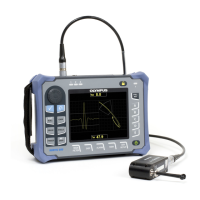DMTA-10040-01EN, Rev. E, February 2018
Chapter 5280
Figure 5‑222 The NFT inspection technology
Near-field probes are an excellent alternative to IRIS (internal rotating inspection
[ultrasonic] system) and magnetic flux leakage (MFL) probes. NFT technology, which
is based on a simple eddy current exciter (driver)-pickup design, produces signals
that are very easy to analyze. NFT probes also allow a fast pulling speed (up to 1 m/s).
In addition, there is no magnet, which means probe pushing and pulling is easier.
This application uses a probe adaptor operating in differential mode (see Figure 5-223
on page 280). The differential configuration subtracts the signals obtained by both
receiving coils and, as such, is ideal for detecting smaller discontinuities such as
pitting (see Figure 5-224 on page 281). The differential configuration, however, cannot
be used to detect longer or gradual discontinuities for the simple reason that the
discontinuity signal is “subtracted” (diminished) and therefore not useful. To detect
longer or gradual discontinuities, absolute mode (with appropriate adaptor) must be
used.
Figure 5‑223 The differential exciter‑pickup configuration
Aluminum-finned
carbon steel tube
Absolute channel
Exciter coil
Magnetic flux and eddy
currents are restricted to
tube ID.
Differential channel

